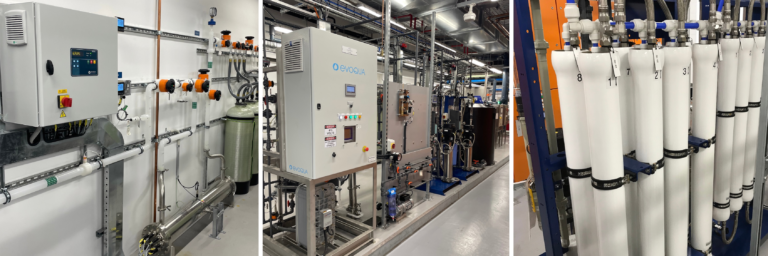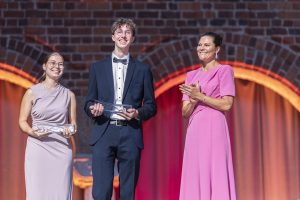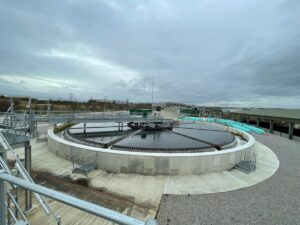Silanna Semiconductor Produces Ultrapure Water with Multi-Stage Solution

Silanna Semiconductor Produces Ultrapure Water with Multi-Stage Solution (Image source: Xylem Inc.)
Silanna Semiconductor is an Australian company specialized in the design and manufacture of advanced semiconductors. It has established itself as a market leader, providing power control and UVC LED semiconductors to the communications, space, defense, medical, and consumer markets. With dedicated offices in North America, Europe, Asia, and Australia, the company maintains a global presence and serves a range of industries.
With the new Brisbane facility, Silanna Semiconductor planned to expand its production of state-of-the-art UVC LEDs, which require ultrapure water (UPW) to prevent contamination. Like many advanced manufacturing processes, even minimal amounts of contamination (as low as parts per billion) can cause a significant drop in production efficiency and lead to costly waste.
The Brisbane facility needs Type E-1 ultrapure water, according to the standards of ASTM D5127-13, which requires a total organic carbon (TOC) content of fewer than 5 ppb and a resistivity of 18.1 MΩ.cm. To meet and maintain these requirements within its production processes, Silanna Semiconductor needed a complete treatment solution for ultrapure water.
Three stages to produce UPW from municipal water
Evoqua, a Xylem company, proposed a customized, multi-stage solution for Silanna Semiconductor that would produce UPW from readily available municipal town water. The Evoqua team managed all aspects of the project, including design, equipment supply, installation, commissioning, and servicing. The process was divided into three stages: pretreatment, primary deionization, and a UPW polishing loop. By leaning on Evoqua's in-house technology and expertise, Silanna received a custom solution that was designed to ensure optimal performance and water efficiency.
1. Pretreatment:
- Vantage PTC multimedia filters reduce suspended solids in the feed water.
- Vantage PTC carbon filters remove chlorine, chloramines and organics from the feed water.
- The Vantage reverse osmosis system removes dissolved solids, as well as bacteria and viruses.
2. Primary deionization:
- Ionpure continuous electrodeionization (CEDI) modules remove weakly charged or ionized compounds without the use of chemicals, which significantly increases safety and lowers operating costs.
3. UPW polishing loop:
- The ATG UV - VT TOC reduction system is designed for the electronics industry and reduces total organic carbon (TOC) in UPW processes.
- SDI (Service Deionization) polishing mixed beds remove minerals and salts without the need for costly regeneration equipment and chemicals on-site. An SDI bed uses the same ion-exchange process, but the used vessel is replaced and removed from the system, reducing exposure for operators.
Exceeding UPW requirements and improving sustainability
During pre-commissioning, sampling results showed that the system had already achieved one of the key milestones: producing water with a resistivity of 18.1 MΩ.cm. This success meant that UPW could be directed from primary deionization into the polishing loop for treatment.
To validate the system’s performance, water quality samples were collected over several months and sent to certified third parties for testing. The equipment and process design exceeded the company’s expectations, delivering a recorded TOC level of 2.1 ppb and resistivity greater than 18.1 MΩ.cm for the UPW.
“We are extremely pleased with the performance and reliability of the Evoqua UPW system,” said Peter Neville, Facilities Manager at Silanna Semiconductor. “The customized solution not only exceeded our stringent water quality requirements but also demonstrated a commitment to sustainability by optimizing water efficiency and reducing chemical consumption. We look forward to continued collaboration with Evoqua as a trusted partner in our ongoing success.”
With the solution, serviced by Evoqua, Silanna Semiconductor reduced the time it spends on maintenance and sanitization, which minimizes production downtime. This allows Silanna Semiconductor to focus on its core business with full confidence that its UPW system will continue to meet high standards.
The solution also improved the sustainability of Silanna Semiconductor’s operations. The treatment solution helped the company achieve its environmental goals for water efficiency by converting 70% of municipal water to Type E-1 UPW. In addition, the use of Evoqua’s innovative Ionpure CEDI system eliminated the need for regeneration chemicals, reducing both chemical consumption and water waste. Furthermore, the ATG UV - VT TOC reduction system decreased the frequency of replacing polishing mixed beds, minimizing production downtime and contributing to a more sustainable production process.
Source: Xylem Inc.





